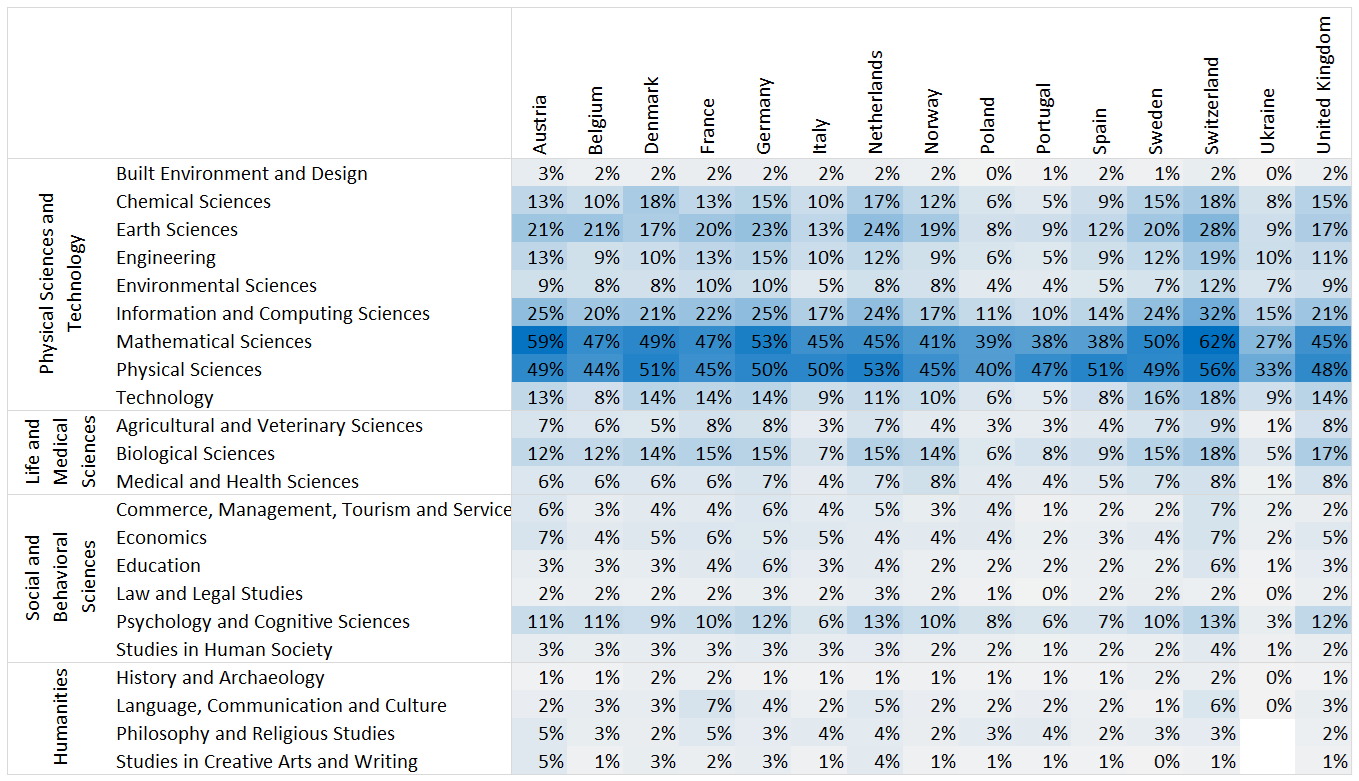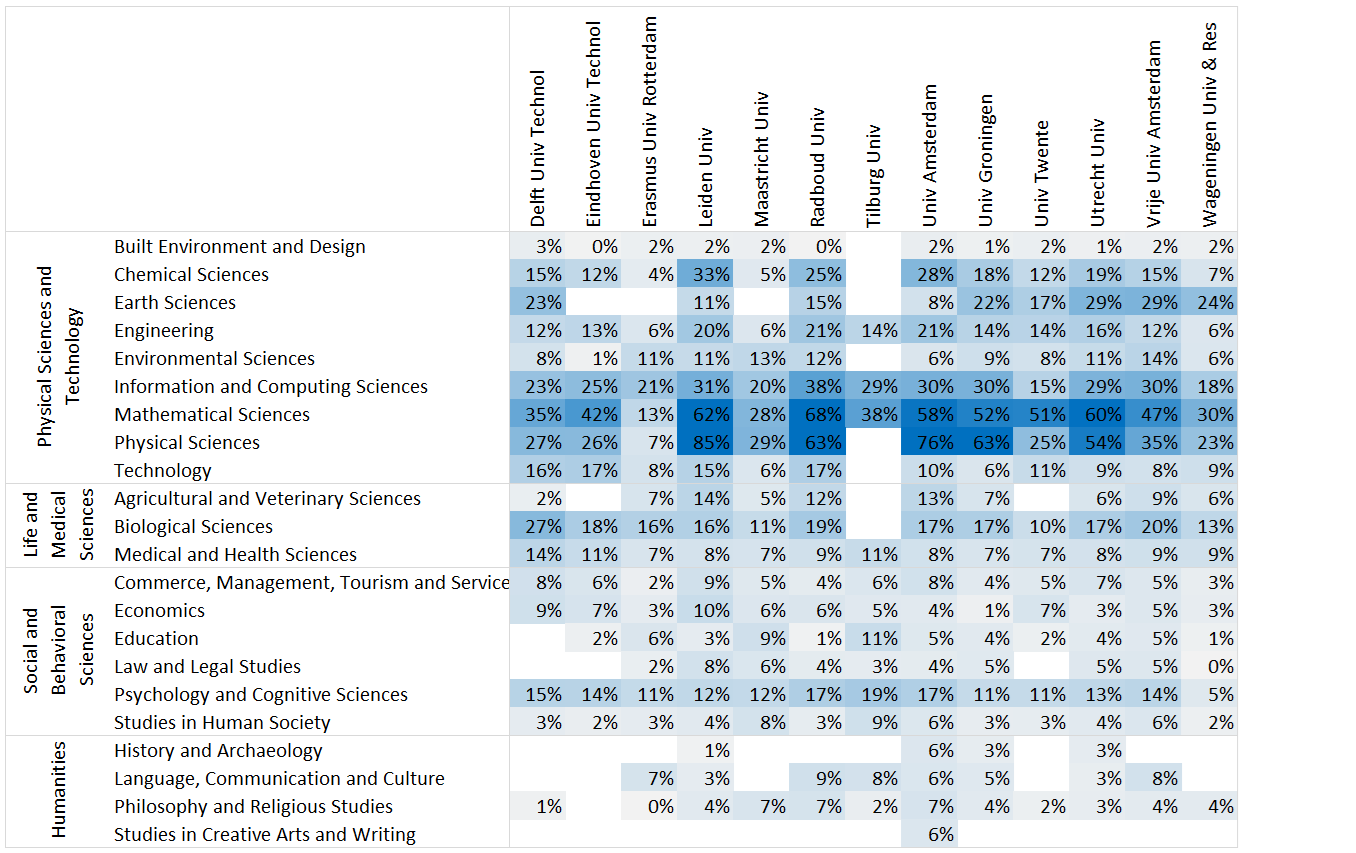The state of preprinting in Europe and the Netherlands
A preprint is a research article that is made openly available on a preprint server, typically before submission to a peer-reviewed journal. Preprinting enables new scientific knowledge to be shared in a timely and open way. It often takes many months or even years for an article to pass through the peer review process of a journal. By preprinting their work, authors can prevent lengthy delays in the dissemination of their research, thereby contributing to speeding up progress in science.
In a paper published recently on the SocArXiv preprint server, we analysed the global adoption of preprinting, including variations by discipline and region. Based on bibliographic data on many millions of research outputs, we estimated the percentage of peer-reviewed outputs (published in scientific journals, books, and conference proceedings) that have been posted as a preprint. The data we used, obtained from the Dimensions, OpenAlex, and Crossref databases, has several limitations, making it hard to determine the percentage of preprinted outputs in a fully accurate way. Nevertheless, even though providing a comprehensive picture of the adoption of preprinting is challenging, our statistics do offer crucial insights into preprint adoption, and in particular into disciplinary and regional differences.
Our paper analyses differences in the adoption of preprinting at a global level. It shows, for instance, that in many disciplines preprint adoption is much higher in North America and Western and Northern Europe than in Africa and Asia. The downside of a global analysis is that more local differences in preprint adoption can easily get obscured. In this post, we therefore use the data collected in our study to zoom in on the adoption of preprinting in Europe and more specifically in the Netherlands.
Preprint adoption in Europe
To analyse the adoption of preprinting in Europe, we consider the 15 European countries (excluding Turkey and Russia) with the largest number of peer-reviewed outputs in the Dimensions database in 2021 and 2022. For each of these countries and each of the 22 high-level disciplines in the Dimensions Fields of Research classification, Figure 1 shows the percentage of peer-reviewed outputs published in 2021 and 2022 that have also been posted as a preprint. We focus on 2021 and 2022 because these are the most recent years for which we have reasonably complete data.

In terms of disciplinary differences in preprint adoption, the patterns for Europe shown in Figure 1 are broadly similar to the global patterns presented in our paper. The highest adoption of preprinting can be found in physics and mathematics. In many European countries, about half of the peer-reviewed outputs in these disciplines have been posted as a preprint. In the information and computing sciences and the earth sciences, many European countries have about 20% preprinted outputs. These disciplines are followed by chemistry, engineering, technology, biology, and psychology, where many European countries have between 10 and 15% preprinted outputs. In the remaining disciplines, typically less than 10% of the peer-reviewed outputs have been preprinted, although we should emphasize that in some disciplines, in particular economics, our statistics underestimate the actual adoption of preprinting (e.g., working papers in economics are not included in our statistics).
There are substantial differences in preprint adoption between European countries. The adoption of preprinting is relatively low in countries in Southern Europe (Italy, Portugal, and Spain) and Eastern Europe (Poland and Ukraine). Especially Ukraine is lagging behind in preprint adoption. The adoption of preprinting is higher in Western and Northern European countries. Switzerland stands out as the country with the highest preprint adoption in many disciplines.
Preprint adoption in the Netherlands
As shown in Figure 1, the Netherlands is one of the European countries with a relatively high adoption of preprinting. To get a better understanding of preprint adoption in the Netherlands, Figure 2 presents statistics for the 13 large universities in the country. Research outputs were assigned to a university using the approach taken in the CWTS Leiden Ranking Open Edition.


For each university, Figure 2 shows disciplines in which the university performs relatively well in terms of preprint adoption and disciplines in which preprint adoption is less satisfactory or even almost completely non-existent. Universities may use this information to make targeted efforts to improve preprint adoption, focused on disciplines in which adoption is lagging behind.
Interestingly, even within a discipline, there can be large differences between universities in the adoption of preprinting. For instance, in physics, mathematics, and chemistry, Leiden University has 85%, 62%, and 33% preprinted outputs, respectively, while only 7%, 13%, and 4% of the outputs of Erasmus University Rotterdam in these disciplines have been preprinted. These statistics indicate there is a lot of room for improvement in preprint adoption at Erasmus University Rotterdam. However, the broad scope of the disciplines also hides important information. In the physics discipline, for example, a majority of the outputs of Leiden University deal with astronomy research. In contrast, most of the physics outputs of Erasmus University Rotterdam are interdisciplinary studies at the interface between physics and medicine, authored by researchers from Erasmus MC, the medical centre of the university. Statistics at the global level show that preprinting is widely practiced in astronomy, while it is still relatively uncommon in medicine. The difference between Leiden University and Erasmus University Rotterdam in preprint adoption in the physics discipline is in line with these global patterns.
Promoting preprinting
As shown in our paper, the adoption of preprinting has grown substantially in recent years. Nevertheless, preprint adoption is still quite low in many disciplines, even in Western and Northern European countries, which are ahead of many other countries in terms of preprint adoption. Low preprint adoption delays the dissemination of scientific knowledge and therefore harms progress in science.
How can preprinting be promoted? In a recent survey of researchers, integrating preprinting in journal workflows was identified as the most important way to promote preprinting, followed by providing recognition to researchers for preprinting their work. Other ways to promote preprinting, considered somewhat less important by the surveyed researchers, include encouraging or mandating preprinting by research funders, research institutions, and journals as well as offering preprint training to researchers.
The survey findings indicate actions that can be taken at the national and institutional level to improve the adoption of preprinting. Integration of preprinting in journal workflows requires coordination between scientific publishers, preprint servers, and other providers of publishing infrastructures. Pushing for this may be challenging for national and institutional stakeholders. However, encouraging preprinting, providing recognition for preprinting, and offering preprint training are actions that should be within reach for stakeholders at the national and institutional level. Given the low preprint adoption in many disciplines, these actions need to get more priority. Further efforts also need to be made to better understand the cultures and practices in different disciplinary communities that promote or discourage preprinting. Achieving greater awareness of the value of preprinting, and of the drivers and barriers within specific disciplines, is essential.
In Europe, Western and Northern European countries seem more successful in promoting preprinting than their Southern and Eastern European neighbours, suggesting there may be opportunities for the latter countries to benefit from the experiences of the former ones. In the Netherlands, favourable conditions for preprinting are being created by national initiatives such as the 'recognition and rewards' program, the allocation of funding for recognising and rewarding open science, and the development of a 'practical guide to preprints'. However, the actual adoption of preprinting needs to take place within universities and other research institutions. Differences in the local implementation of national initiatives are likely to lead to differences between institutions in preprint adoption, in line with the statistics shown in Figure 2. Sharing of best practices between institutions seems crucial.
Preprint adoption elsewhere in the world
Are you interested in the adoption of preprinting elsewhere in the world, outside the Netherlands or outside Europe? The data set we have made available along with our paper provides statistics like those in Figure 1 for all countries in the world. The data set also includes the DOIs of the more than two million peer-reviewed outputs for which a corresponding preprint has been identified. In addition, we have made available a separate data set in which statistics like those in Figure 2 are provided for all 1506 universities in the most recent release of the CWTS Leiden Ranking Open Edition.
Hopefully these data sets will be helpful to develop a more in-depth understanding of the adoption of preprinting in different parts of the world. Ultimately, we hope this will contribute to making preprinting the norm in scientific publishing worldwide!
DOI: 10.59350/h5cx3-7yn67 (export/download/cite this blog post)
Note: an earlier version of this blog post did not feature the elaboration following the sentence that begins: "In the remaining disciplines, typically less than 10% of the peer-reviewed outputs have been preprinted".
Additional details
Description
A preprint is a research article that is made openly available on a preprint server, typically before submission to a peer-reviewed journal. Preprinting enables new scientific knowledge to be shared in a timely and open way. It often takes many months or even years for an article to pass through the peer review process of a journal.
Identifiers
- UUID
- eb391d3a-defe-4bb8-b4d2-959ce04259e7
- GUID
- https://www.leidenmadtrics.nl/articles/the-state-of-preprinting-in-europe-and-the-netherlands
- URL
- https://www.leidenmadtrics.nl/articles/the-state-of-preprinting-in-europe-and-the-netherlands
Dates
- Issued
-
2025-05-22T10:30:00
- Updated
-
2025-09-28T13:39:58
